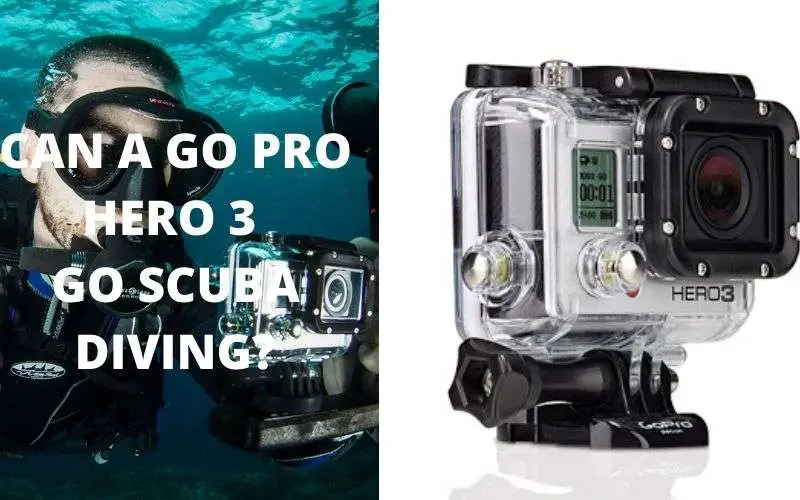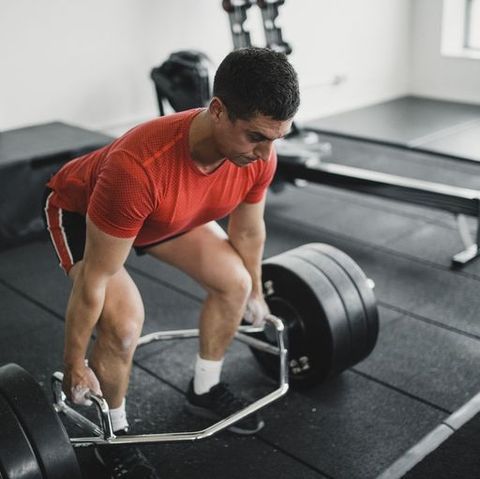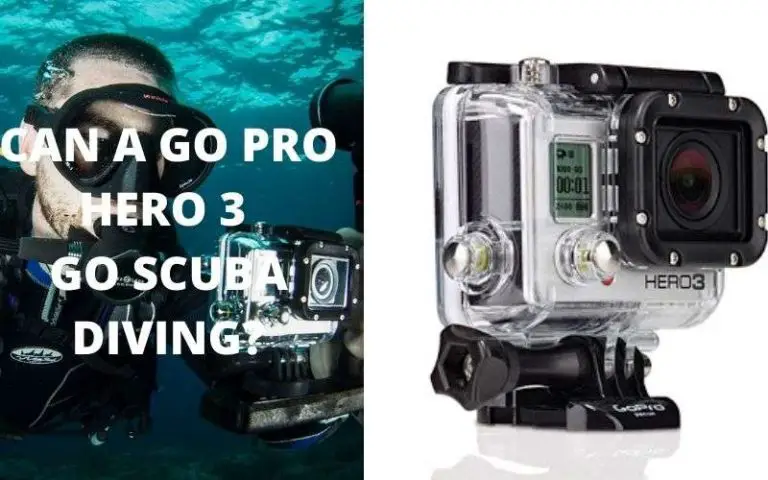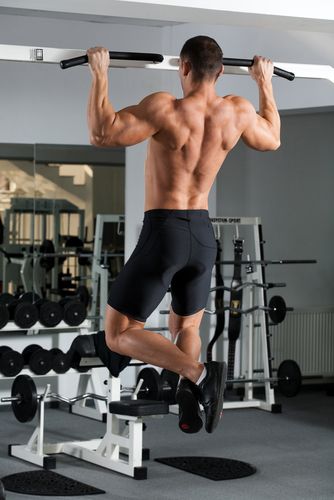
In the world of competitive swimming, every fraction of a second counts. To stay ahead of the pack, swimmers must invest in rigorous training routines that go beyond laps in the pool. One exercise that stands out for its impact on swimming performance is the pull-up.
This article explores the myriad benefits of pull-ups for swimmers and provides valuable insights into incorporating them into your training regimen.
The Benefits of Pull-Ups for Swimmers
Enhancing Swimming Performance
Swimmers looking to boost their speed and endurance in the water should seriously consider integrating pull-ups into their workout routine. This exercise targets the core, back, arms, and traps, all of which are fundamental to swimming. By strengthening these muscle groups, swimmers experience significant improvements in their overall performance.
Furthermore, the benefits of pull-ups extend to refining swimming technique. As the arms and shoulders grow stronger, swimmers can maintain an efficient arm pull and proper body positioning, both of which are essential for success in the pool.

Strengthening Key Muscle Groups
A primary advantage of pull-ups lies in their ability to target the exact muscle groups crucial for effective swimming. This comprehensive exercise engages:
Latissimus Dorsi (Lats)
These large back muscles contribute significantly to propulsion in the water.
Biceps and Forearms
Crucial for the initial catch and follow-through phases of a stroke.
Rear Deltoids and Trapezius
These muscles stabilize the shoulders and provide power during strokes.
Core Muscles
Improved core stability leads to enhanced speed and efficiency in the water.
When these muscle groups are robust, swimmers can push water more effectively and generate the propulsion necessary for faster, more powerful strokes.
Reducing the Risk of Injury
One common concern for swimmers is the potential for shoulder injuries, often referred to as “swimmer’s shoulder.” Regularly practicing pull-ups can significantly mitigate this risk.
They strengthen the rear deltoid muscles and traps, providing stability to the shoulder blades and supporting the rotator cuff muscles. Moreover, pull-ups double as an excellent core exercise, enhancing the body’s overall stability in the water.
A strong core is critical for both injury prevention and the execution of proper swimming techniques.
How to Start and Progress with Pull-Ups
To unlock the benefits of pull-ups, it’s crucial to progress from your current fitness level. Not everyone can perform a full pull-up initially. Here’s a step-by-step guide to getting there:
Begin with Bodyweight Rows
If full pull-ups seem daunting, start with bodyweight rows. Set up a bar at waist height and lie beneath it. With an overhand grip, pull your chest towards the bar by engaging your back muscles. As you gain strength, move on to inverted bodyweight rows by placing your feet on an elevated surface.
Utilize Assisted Pull-Ups
Transition to assisted pull-ups using a resistance band or an assisted pull-up machine. This allows you to practice the pull-up form while reducing the weight on your arms.
Incorporate Top Holds and Bar Hangs
These exercises will improve grip strength and help develop the muscles needed for pull-ups. Hold onto the pull-up bar with an overhand grip for as long as possible. Additionally, practice top holds by jumping into the top pull-up position and holding it for a few seconds before lowering yourself down.
Master Negative Pull-Ups
Position yourself in the top pull-up stance, then lower yourself down gradually, taking at least five seconds to reach the bottom position. Repeating this process ensures that you’re in control throughout the descent.
Achieve Your First Unassisted Pull-Up
With enough strength built up, attempt your first unassisted pull-up. Focus on engaging your back muscles and keeping your core tight during the movement. It might take several attempts, but perseverance is key.
Increase Set and Rep Numbers
After accomplishing your first pull-up, aim to increase your set and repetition numbers. Do as many pull-ups as possible, then transition to band-assisted pull-ups and negative pull-ups. Experiment with different grip styles to target diverse muscle groups in your back and arms.
Explore Advanced Variations
Once you’ve mastered standard pull-ups, explore advanced variations such as weighted pull-ups, archer pull-ups, and muscle-ups to further challenge your strength and enhance your swimming performance.
Remember that progress takes time, and consistency is vital. Stay committed to each stage, monitor your improvements, and witness the benefits of pull-ups enhance your swimming skills.
The Significance of Proper Pull-Up Technique
While pull-ups are immensely beneficial for swimmers, the importance of proper form cannot be overstated. Proper technique ensures that you effectively target the muscles used in swimming, such as the lats, shoulders, and back. It also aids in building upper body endurance, leading to enhanced in-water performance.
Here are some key points to remember for correct pull-up technique:
- Start with a Full Hang: Begin with arms extended and shoulders relaxed. This position ensures that you engage the right muscles and work your entire back effectively.
- Lead with Your Chest: While pulling up, focus on leading with your chest, driving your elbows down and back. Maintaining a slight arch in your lower back helps maintain proper alignment and prevents unnecessary strain on your shoulders.
- Engage Your Core: Keep your core engaged throughout the movement and avoid swinging your hips or legs. As you reach the top with your chin above the bar, lower yourself back down smoothly to the starting position.
Experiment with Different Hand Positions
In addition to the standard pull-up, swimmers can experiment with various hand positions to target specific muscles. For instance, wide-grip pull-ups simulate the wider arm position used during the pull phase of a swimming stroke, emphasizing the lats, the largest muscles in the back.
Regardless of the variation you choose, maintaining proper form is essential, even if it means doing fewer reps initially. Building strength with good technique ensures that the benefits of pull-ups translate directly into improved swimming performance.
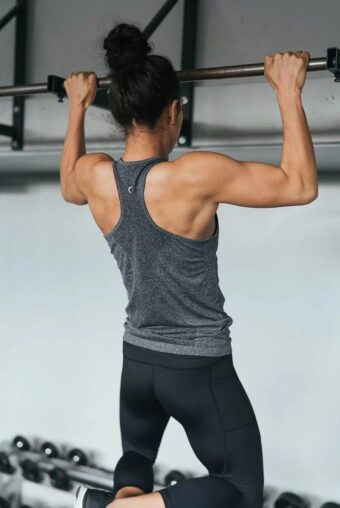
Incorporating Pull-Ups into Swim Training
Ideal Frequency and Volume
Achieving the right balance between building strength and avoiding overtraining is crucial. Aim to include pull-up exercises in your dryland strength training routine 2-3 times a week. Begin with a manageable number of repetitions, like 3 sets of 6-8 pull-ups, and gradually increase volume as your strength and endurance improve.
When starting pull-ups for the first time, it’s normal to do a low number of repetitions. In such cases, you can mix pull-ups with negative pull-ups to achieve the recommended volume.
Pull-Up Variations and Alternatives
As you advance in your training, consider integrating different pull-up variations and alternatives to continually challenge your muscles and enhance your performance:
Chin-Ups
By changing your hand position to have your palms facing towards you, you engage your biceps while still strengthening your back and other swimming muscles.
Inverted Rows
This regression using a bar or TRX straps laid at waist height is excellent for building strength, especially if you struggle with standard pull-ups.
Flexed Arm Hang
Start in a full pull-up position and hold your chin above the bar for as long as possible. This exercise improves grip strength, endurance, and stabilizer muscles, enhancing your pulling power in the water.
Assisted Pull-Ups
If you’re not yet able to perform unassisted pull-ups, consider using a resistance band or an assisted pull-up machine. These tools will support a portion of your body weight, allowing you to complete more repetitions and build confidence in your pulling motion.
Remember that the key to a successful pull-up training program is to listen to your body and identify the progression and variation that suits your level of strength and expertise.
By integrating pull-ups into your swim training, you’ll experience heightened core strength, more potent strokes, and an overall improvement in your swimming performance.
Frequently Asked Questions
Is it Normal to Be Unable to Do a Single Pull-Up?
Absolutely. It’s entirely normal, especially for beginners or those who haven’t focused on upper-body strength training. Pull-ups are a demanding exercise, requiring strength in multiple muscle groups like the lats, biceps, and core. With consistent training and correct technique, most individuals can progress to performing one or more pull-ups.
Is It Impressive to Do 20 Pull-Ups in a Row?
Yes, doing 20 consecutive pull-ups is indeed impressive. This achievement demonstrates a high level of upper-body strength and endurance. Many fitness tests consider completing over 12 to 15 pull-ups in a row as exceptional, making 20 in a row a testament to a robust and well-conditioned physique.
How Many Pull-Ups Can Michael Phelps Do?
Michael Phelps, one of the greatest swimmers in history, is rumored to have a personal record of over 30 pull-ups in a row, with some sources stating that his record stands at 34. His ability to perform such a number underscores the role of pull-ups in building the strength required for elite swimming.
Are There Any Potential Drawbacks or Risks for Swimmers Doing Pull-Ups?
As with any exercise, there are potential risks associated with pull-ups, especially when performed improperly or excessively. Incorrect form can lead to injuries such as strains or tendonitis.
Overuse or insufficient rest and recovery can result in overtraining, which may cause decreased performance, chronic fatigue, and an increased risk of injury. Swimmers must incorporate pull-ups correctly into a well-structured training routine, using proper form and allowing for adequate rest and recovery.
What Are Signs That a Swimmer Might Be Overdoing It with Pull-Ups?
Signs that a swimmer might be overtraining with pull-ups include persistent or increasing pain in the shoulders, elbows, or wrists.
Other indicators of overtraining include decreased performance or progress, difficulty in completing sets that were previously manageable, excessive fatigue following training, interrupted sleep, mood changes, loss of appetite, or an unusually high resting heart rate.
These symptoms should serve as red flags, prompting a reassessment of the training regimen to prevent overuse injuries and maximize progress in swimming performance.



